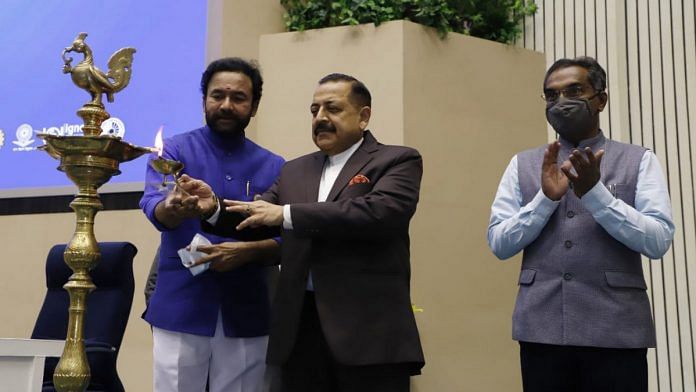New Delhi: Vigyan Sarvatra Pujyate — a countrywide, week-long science festival — was inaugurated at the Vigyan Bhavan in Delhi Tuesday, as a part of the Narendra Modi government’s year-long Azadi Ka Amrit Mahotsav programme.
With exhibitions spread across 75 locations throughout the country, Vigyan Sarvatra Pujyate (literally, ‘science is worshipped everywhere’) aims to showcase and pay homage to India’s achievements in 75 years of Independence.
The exhibition, which will be showcased till 28 February, will put on display India’s scientific legacy and technology prowess that have helped find solutions to problems in defence, space, health, agriculture, astronomy, and others.
The event is jointly organised by the Department of Science & Technology (DST), Department of Biotechnology (DBT), Council of Scientific & Industrial Research (CSIR), Ministry of Earth Sciences (MoES), Department of Atomic Energy (DAE), Department of Space (DOS), Indian Council of Medical Research (ICMR), All India Council for Technical Education (AICTE), and Defence Research and Development Organisation (DRDO), under the leadership of the office of the Principal Scientific Adviser to the government of India and the Ministry of Culture.
The central agencies will work with state agencies to bring to the fore stories of people in science who made these achievements possible, and reinforce the commitment of the scientific community towards India’s economic and social development.
Also read: Beyond Modi waves, Ravana airports: What media failed to report on Indian Science Congress
Aim to transform India
The festival aims to highlight the work being done by research and development organisations from across the country, and their ideas for the road ahead to 2047, the 100th anniversary of Independence.
“Pre-Independence India saw the successes of great individual scientists who contributed in a world where scientific institutions were sparse. There were great scientists like Meghnad Saha, Janki Amal, Ramanujan, C.V. Raman who made extraordinary contributions,” Principal Scientific Adviser K. VijayRaghavan said at the inaugural event Tuesday.
He added that post-Independence, major institutions like the CSIR, DAE, DST and DRDO were developed.
“These institutions transformed research and development in India by interacting with the universities system in a manner that the best students came to these institutions and extraordinary work was done in fundamental research as well as in applications,” he said.
However, he added, for a variety of reasons, the university system became a feeder to research institutions, while less and less research was being done at the university level. This is not the way things have happened in rest of the world, he pointed out.
The new National Education Policy aims to correct this by bringing research and teaching together. It aims to ensure that quality research takes place at the university level as well, he said.
“The sense of the programme is that there has been a tremendous scientific achievement in the recent past, but how best to incorporate it in our cultural ethos? The longer we look back, the further we look forward,” said Union Minister for Science and Technology as well as Earth Sciences, Dr Jitendra Singh.
“How best to combine the Indian tradition with the Indian scientific advancement, that is the crux of the programme,” Singh added.
Also read: Jagdish Chandra Kapur — the Indian Alvin Toffler who stood by the promise of technology
Thematic exhibitions
Programmes are being organised simultaneously at 75 locations all over the country, including a mega expo and book fair at the grounds of Jawaharlal Nehru Stadium in New Delhi.
Four themes have been identified for the week-long celebration. The first is ‘Annals of Science’, which will trace how an individual’s contributions helped India establish a modern science and technology system. This includes institutions of national importance that were established in India in the past seven years, and how they have contributed to nation-building.
The second theme is ‘Milestones of Modern S&T’, which will explore key discoveries, innovations or inventions that made a mark in the global science or India s development story.
The third theme is ‘Swadeshi Paramparik Inventions & Innovations’, which will highlight inventions or technologies that helped India’s goal of self-reliance, including modern innovations that draw upon the reservoir of the traditional knowledge system.
The fourth theme is ‘Transforming India’, which will cover grand science and technology missions, such as Gaganyaan and Samudrayan.
The programme will end with a grand valedictory function, on National Science Day, celebrated on 28 February every year since 1987, in memory of Nobel Laureate Sir C.V. Raman’s path-breaking discovery of the Raman Effect in 1930.
(Edited by Manoj Ramachandran)
Also read: ISRO successfully launches new earth observation satellite in 2022’s first launch



